Amid the green plains of England, dozens of rocks emerge from the gloomy morning mist, still hiding many secrets from humans. Open your eyes, for though it sounds like a fairy tale, this is the story of a real, albeit truly unbelievable, place.
Stonehenge is probably the most famous prehistoric monument in the world. The stone circle is located in southern England, about 13 km from the city of Salisbury and the Salisbury Plain. Each year, over a million visitors come to witness this prehistoric wonder, listed as a UNESCO World Heritage Site. Among them are those who, seeking a bit of magic in their everyday lives, gather at this ancient monument to observe the most beautiful sunrise during the summer solstice.
The Origins of Stonehenge
Archaeologists believe that the famous prehistoric ruins in England were built in several stages. The earliest constructions were erected at least 5,000 years ago, while the unique stone circle itself was raised around 2500 BC. It’s difficult to present any precise details about the exact construction process today. Nevertheless, through specialized studies conducted by experts, we know that work on Stonehenge continued until about 1600 BC, and most of the stones were repositioned several times.
FUN FACT: Stonehenge has long fascinated people. In 1620, George Villiers, the Duke of Buckingham, dug a large hole right in the center of the circle. Why? Of course, he was looking for treasure. As you might guess, he didn’t find any valuables but didn’t return home empty-handed either. Although… a bit of charcoal and animal antlers aren’t exactly priceless discoveries.
The Stones That Make Up Stonehenge
Two types of stone were used to create the iconic circles that now attract millions of tourists. The larger stones are known as sarsen stones, which form the outer ring. If you look inside this ring, you’ll notice a smaller circle made of the so-called bluestones.
At first glance, it’s hard to see the blue tint of these stones, but when they’re wet or freshly broken, the rocks glimmer with a beautiful bluish hue in the sunlight. Among these bluestones, at the very center of Stonehenge, is the Altar Stone, the largest unhewn stone, which likely played a significant ritualistic role in the past.
The magic of Stonehenge is shaped by all the standing stones in the circle, but some have developed their own unique “personalities” and stories over the centuries. Take, for instance, the Heel Stone, which curiously stands in isolation from the other sarsens. Perhaps it’s the sole survivor of stones that once stood outside the entrance to the circle. Or maybe it was always intended to stand alone, marking the exact point on the horizon where the sun rises during the summer solstice. This remains uncertain. What is known, however, is that the unique position of this stone has inspired its own legend. According to the story, it was this very sarsen that the devil hurled at the heel of a clever farmer who outwitted him in one of his tricky games.
Why Was the Stone Circle Built?

There is still no definitive answer to this question. The structure was neither inhabited nor served any defensive purpose, which means it lacked any clear practical function. Therefore, there must have been a spiritual reason why people from the Neolithic and Bronze Ages put so much effort into its construction. Some suggest that Stonehenge may have functioned as an astronomical observatory or solar calendar, others believe it was a place of healing or burial, and yet others think it was a temple or gathering place for ancient Celtic priests, the Druids. The one certain piece of the puzzle is that the structure’s function was closely related to planetary movement.
The Cult of the Sun and Moon
Scientists have noted that the position of the sarsen stones at the center of the circle aligns with the movement of the sun. What does this mean? If you visit Stonehenge during the summer solstice, you’ll observe that the axis of the structure points directly to the spot where the sun rises. The construction also tracked the movement of the sun during the winter solstice. It is said that the sun set between two pillars of the structure, finally disappearing behind the all-important Altar Stone. Unfortunately, this effect can no longer be witnessed today as that part of Stonehenge has long been destroyed.
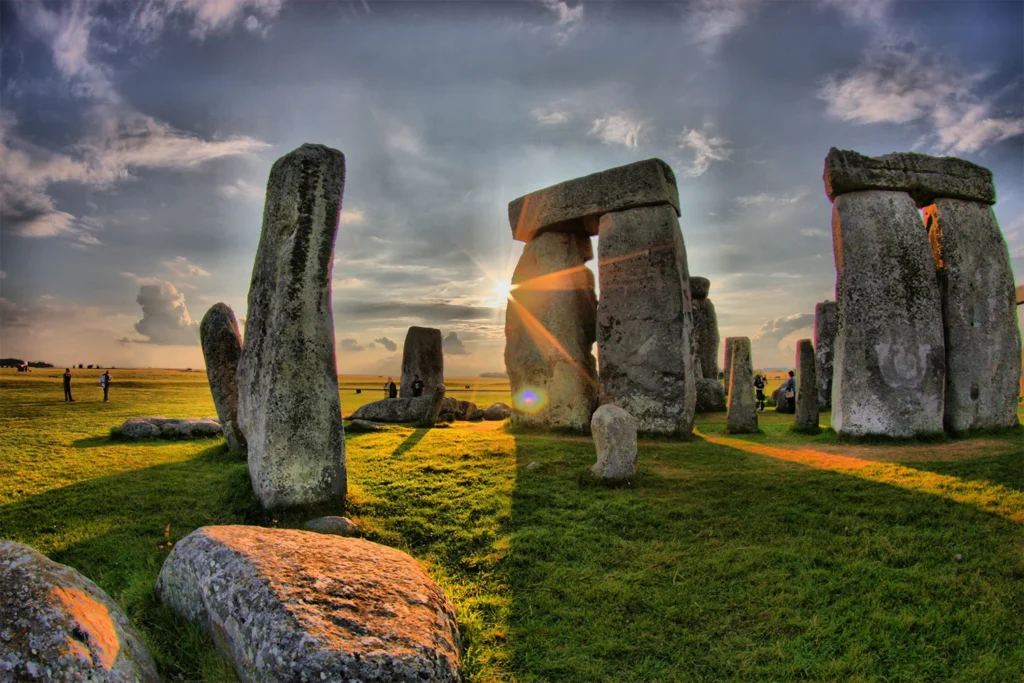
It remains unclear whether observing the sky in Neolithic Britain was a ritual element or simply provided crucial information about the seasons, which were vitally important for people primarily engaged in agriculture and animal husbandry.
How was Stonehenge built?
The mysterious construction methods of this structure are one of the main factors that draw worldwide attention to Stonehenge. After all, this megalithic engineering marvel must have been built by hundreds of people using only the simplest of tools. It’s also important to remember that this was long before the introduction of metals or the invention of the wheel. Yet, they achieved incredible feats!
Simple tools made from animal antlers and bones were used for excavation, and hammerstones and flint were employed to shape and work the stones. To erect the stones, a large hole was dug with a sloping side. The stone was placed in the hole and pulled upright using ropes made from plant fibers. Weights were likely used to tilt the stone, and once it was in the correct position, the holes were filled with rubble to secure it.
People with supernatural strength?
The most incredible aspect, however, is the transportation of the stones. How could massive sarsen stones, averaging 25 tons, be transported without the use of wheels? And this wasn’t just a matter of a few meters—research suggests that these stones were brought from Marlborough Downs, about 32 km (20 miles) away from present-day Stonehenge. The task wasn’t any easier with the smaller stones known as bluestones. Although they weigh between 2 and 5 tons each, researchers believe they originated in southwest Wales, meaning they traveled a staggering distance of nearly 290 km (180 miles).
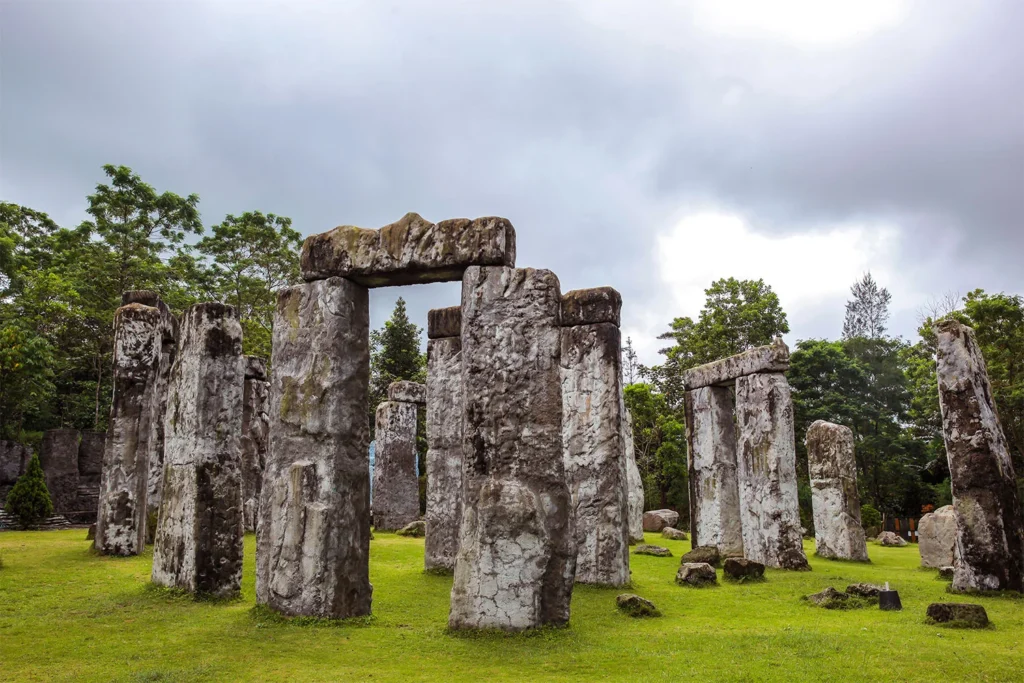
This mystery has baffled experts for centuries and continues to do so today. Some scientists believe in less popular theories. They claim that special wooden platforms or a massive sled-like structure were used for transport, or that part of the journey from Wales was made by loading the stones onto ships. Another popular concept suggests that glaciers did the work for humans. There are also experts who support the simplest theory—that the stones were transported using the strength of many people and animals. However, none of these theories have been definitively proven, leaving room for speculation and fantastic theories to explain what may never be fully understood.
GOOD TO KNOW: Some of you may be wondering who exactly built Stonehenge. Unfortunately, this remains yet another unresolved mystery surrounding the history and origins of the enigmatic circle on Salisbury Plain. The most substantial evidence points to the collaboration of several unidentified tribes from the British Isles. However, if you prefer to believe in magical origins, read on for the legends connected to this mystical circle.
Myths and Legends of the Magical Circle
As befits a magical and mysterious place, Stonehenge has become the source of many intriguing legends. One such legend speaks of giants who lived within the circle and turned to stone while dancing. Another tale portrays the Devil himself as the builder of this sacred site. The story goes that Satan, wishing to use stones belonging to an Irishwoman for the construction, disguised himself as a man and offered her a deal: he would pay her as many gold coins as she could count before he finished placing the stones in the circle. Of course, the offer was far from fair. Using his powers, the Devil transported the stones in an instant, leaving the poor woman with nothing.
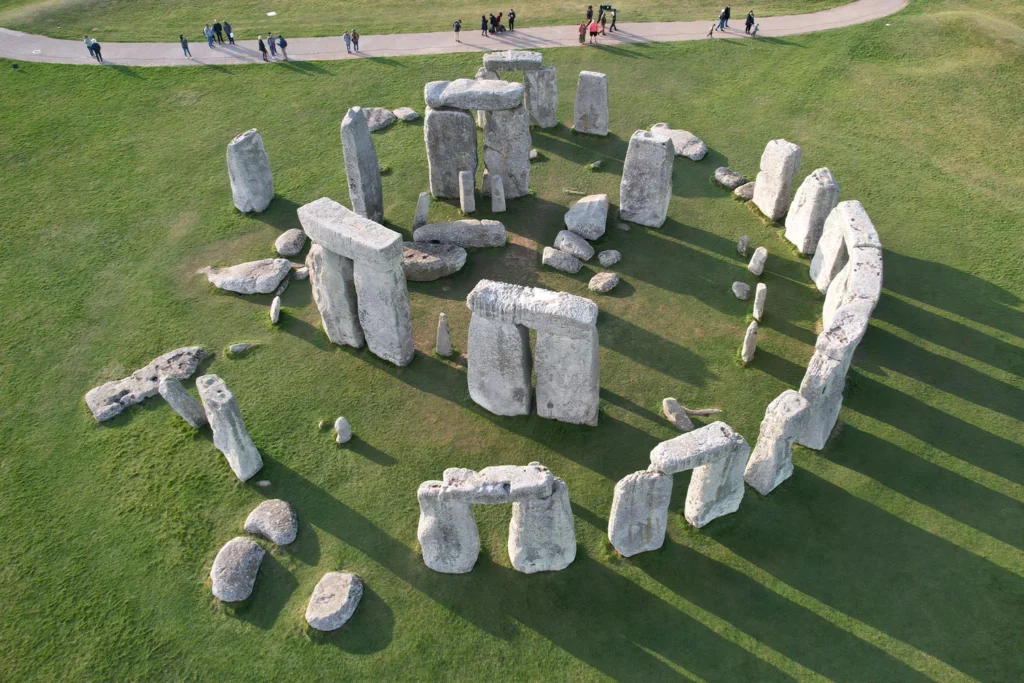
The most popular story, however, involves another figure known worldwide—the wizard Merlin. According to legend, British nobles who fell in battle against the Saxons in the 5th century were buried exactly where Stonehenge stands today. To honor their deaths, the king wished to erect a monument made of magical stones from Ireland. He sent an entire army, led by Merlin, to bring the stones back to England. The Irish fiercely defended their treasure, but the key to the British victory was magic. It was through Merlin’s sorcery that the stones were transported and arranged, creating none other than the present-day Stonehenge.
Stonehenge Visitor Centre
About 1.5 km from the stone circle, a special visitor center was opened in December 2013, a must-see for anyone captivated by the mystery of Stonehenge. The center houses nearly 300 archaeological treasures found near the sacred site. Among them, you’ll find not only jewelry and pottery but also human remains. The museum space is also home to temporary exhibits, where you can view massive stones interpreted by contemporary artists, as well as archaeological artifacts on loan from museums worldwide.
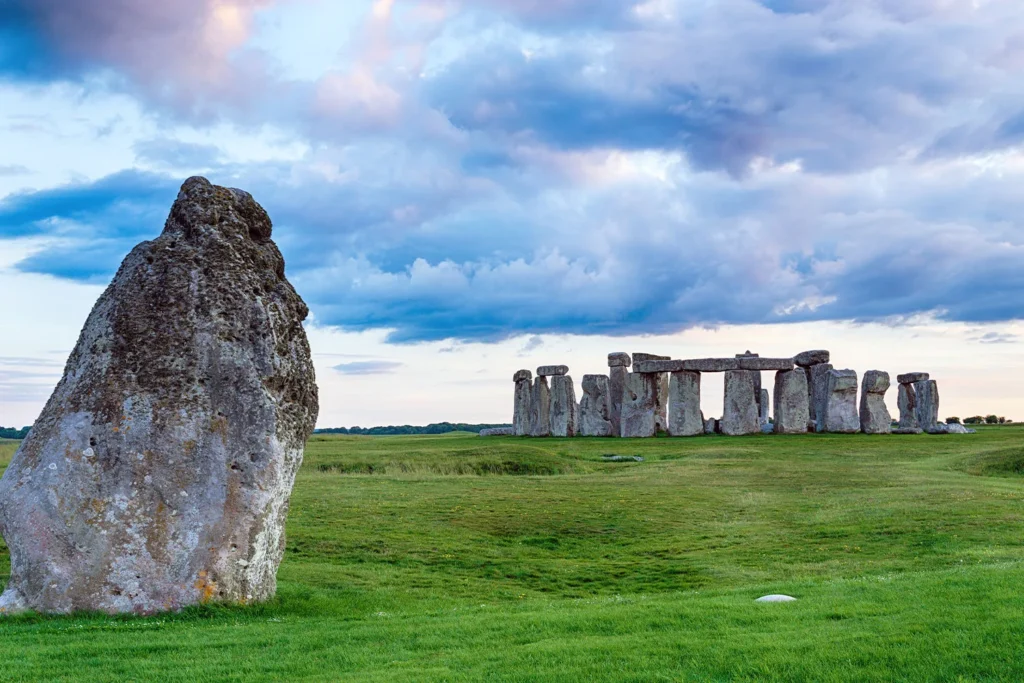
Not only will the exhibits at the Visitor Centre tell you a bit about life in southern Britain thousands of years ago, but you can also explore nearby Neolithic houses that transport visitors 4,500 years back in time. There, you can meet English Heritage volunteers baking bread using ancient recipes or crafting items with Neolithic techniques. This unique attraction will certainly meet your expectations. And if a slice of bread doesn’t satisfy your hunger, remember that there are picnic areas and a café at the museum, serving both hot and cold meals.
Visiting Stonehenge
If you’re looking to save both time and money, be sure to buy your tickets to Stonehenge in advance, for example, through this website. Tickets purchased online are 15% cheaper than those bought at the box office, so it’s worth taking advantage of this. However, keep in mind that ticket prices vary depending on the day and season. You’ll pay less during the week than on weekends, and more in the height of summer than in spring.
What tickets to buy? You have two options. The General Admission ticket is the most basic choice. It grants access to all the facilities and attractions at the Visitor Centre and allows you to see a special exhibition dedicated to the stone circle. This ticket also includes a shuttle bus that regularly takes visitors close to Stonehenge. You can admire the prehistoric architectural marvel and take photos, but be aware—you won’t be able to get right up to the stones. You’ll stop about 10 meters away, near a low barrier.
Does this mean it’s impossible to view the stones up close? Not entirely. If that’s what you dream of, you can purchase the Stone Circle Experience ticket, which lets you personally experience the magic of the mysterious circle. These tours last an hour and take place outside the official opening hours, either early in the morning or right after the site closes. Participation is limited, so it’s best to secure this experience up to a year in advance.
Stone Circles in Avebury
Few people know that Stonehenge isn’t the only monument of its kind in the nearby area. A 45-minute drive (you can rent a car using a service like RentalCars), or, if you’ve booked a guided tour, a bus ride, will bring you to Avebury, where you’ll find another prehistoric wonder of Britain. This site features not only a circular ditch surrounding the village area but also the largest stone circle in the world. According to scientists, the construction at Avebury may even be older than the one we know as Stonehenge.
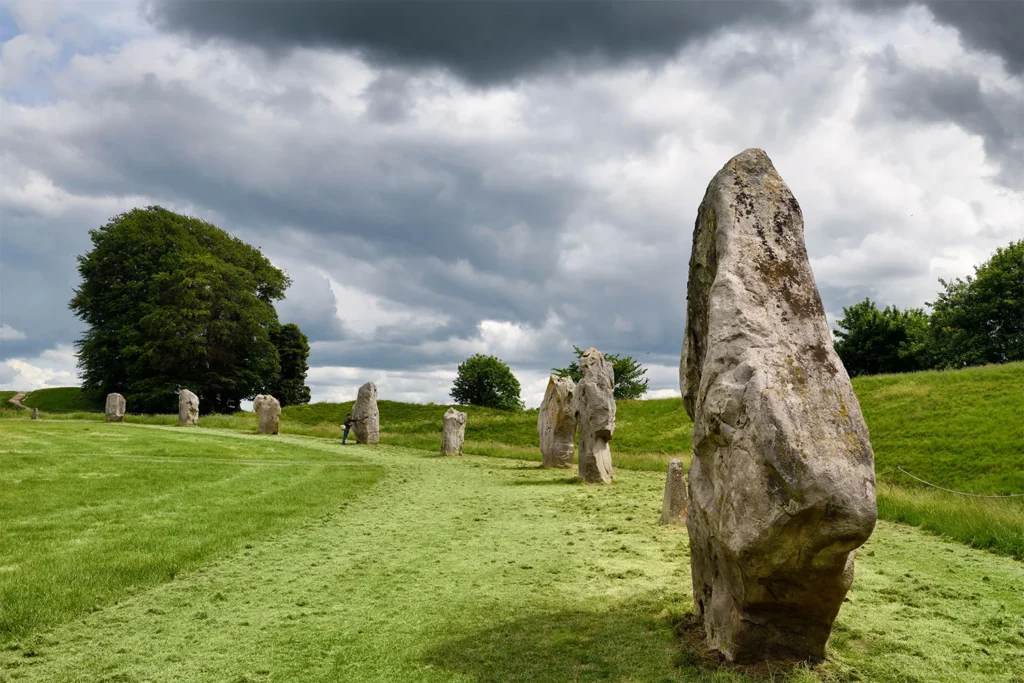
Together with Stonehenge, Avebury and its surroundings are inscribed on the UNESCO World Heritage List, and if you catch the bug and want to uncover more of the area’s mysteries, head to the Alexander Keiller Museum, where findings from the Avebury region are on display.
Practical information
- It is advisable to book tours to Stonehenge in advance. There are many tours available with experienced guides who will show you the most interesting spots, answer your questions, and share fascinating facts about the areas you visit.
- Book a tour on GetYourGuide